Designs are complicated stories narrated in a simple visual and textual language.
An ideal restaurant design impacts the customer’s experience as much as the delicacy on the plate does. A well-thought design concept adds value to the surroundings, from the layout to the table setting and the choice of music to the menu style. Every component affects how people place their orders and how often they visit.
Restaurants that use an accurate theme, balanced colour composition, symmetrical spacing of seating area, curated typography, and aesthetical artwork creates a perfect ambience for an unforgettable dining experience.
THE MOST APPEALING ELEMENTS OF ANY RESTAURANT DESIGN ARE:
- Suave architecture
- Ambient lighting
- Warm colours that stimulate
- hunger and calmness
- Alluring scent of food
- Fitting themes
- Soothing acoustics
A COMBINATION OF THESE EXUDES A PLEASANT VIBE.
Design experts know how to tell a story through their art. The selection of décor, seating capacity, the ratio of the spacing between lights, the wall art, and the alignment of the drinks bar convey the message of a happy meal. These might sound simple to consumers, but each section influences the customer’s psychology.
For instance, fast-food joints have compact seating, and dine-in restaurants have comfortable spaces because the former wants you to leave quickly and the latter wants you to linger longer.
To explain, when you visit McDonald’s, you might notice that while the chairs are comfortable, they are not cosy enough to sit all day. However, if you go to an exquisite dinner place, there are sofas and cushion chairs to ensure customers stay longer and enjoy a fulfilling experience.
We understand the importance of perfectly blending the design elements of shape, size, texture, space, colour, and art to create an impactful brand image of the restaurant. Our design strategy focuses on creating the best design concepts for restaurant spaces using techniques that leave a lasting impression.
RESTAURANT DESIGN CONCEPTS THAT ARE TRULY STUNNING
Restaurant design has to be as tempting as the food to connect with customers and stand out as a brand. Let’s look at four fascinating restaurant design concepts that take your eatery to the next level:
1. FAST-FOOD CONCEPT
Cafés and fast-food restaurants are known for cosy spaces and chic layouts. Expert restaurant designers know how to weave a tale with their artwork.
Observe this design, especially the beautiful colour contrast of pink and white that reminisces customers of milkshakes and doughnuts. You will imagine the taste with your senses and then savour it with your taste buds. It’s simply inviting on a breakfast morning!
The partially natural lighting elevates the customer’s senses and makes them happy. Coupled with colourful accent lights for decor, white and blue radiate warmth to create a delightful restaurant experience. The spacing of lights is done in an optimal proportion to give out a calm ambience to the diners.
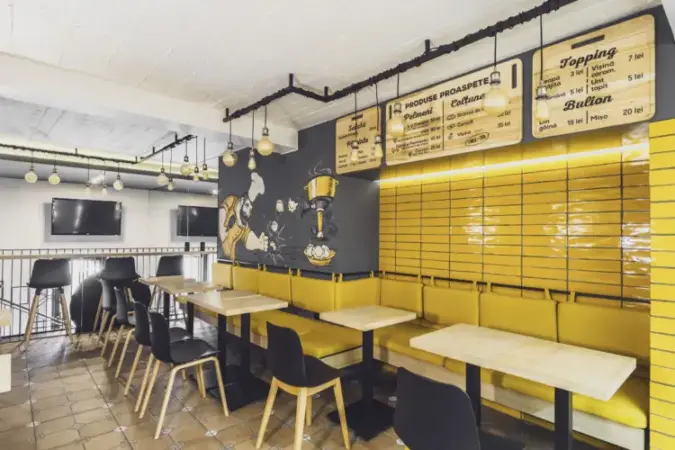
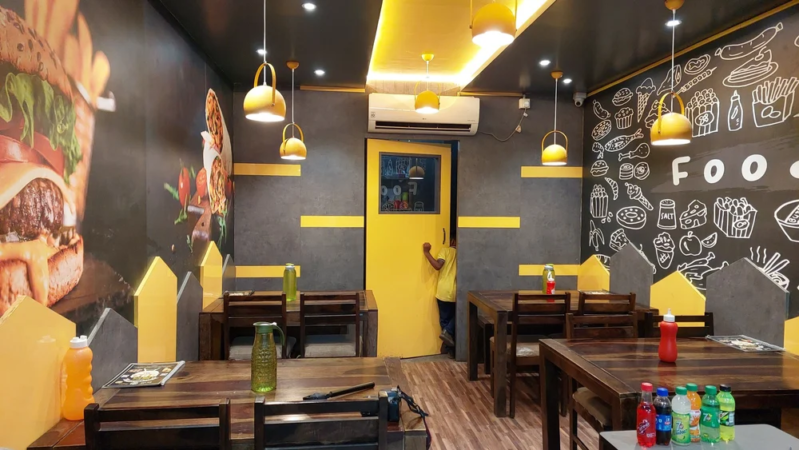
Observe how the long, spacious table can serve many customers in minimal space. People can eat in groups in a close-knit atmosphere, and there are high tables near the window for someone who prefers to have their coffee or work while listening to tunes and looking at the scenery in a quiet corner.
Above this, the blue cupboard can be used for books or magazines to attract readers or store a sample of different items sold on the menu to inform visitors. The flawless walls with graffiti can convey a positive affirmation to the customers. Overall, it combines all the design elements for a heart-warming vibe and serves all kinds of customers.
2. FAST CASUAL RESTAURANT
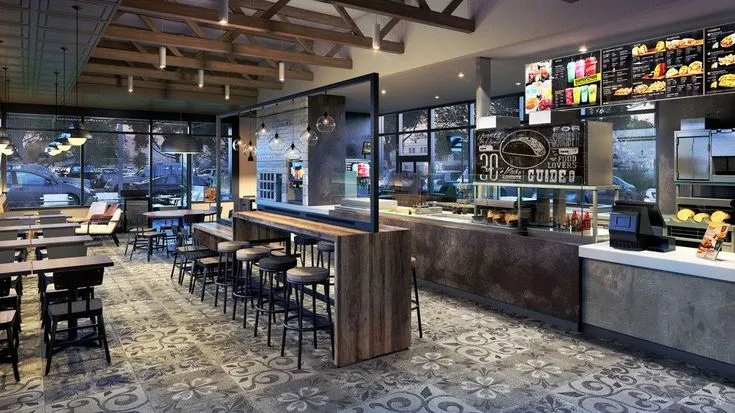

Restaurant designs combining different colour textures to give a fine-dining appearance are charming.
The symmetrical layout of this design gives an organised look, enticing visitors for a relaxing meal. Look at the blend of yellow and red, which heightens appetite. Furthermore, the brown colour depicts cheerful friendliness and sophistication to the customers. The blue adds to the aesthetics, while the black seating looks regal.
The designers have incorporated ambient lighting with task lights to create a warm experience. The best part is the accessibility of the ordering area and comfortable and capacious seating, making it easy for the servers to move.
Observe how the intimate seating alignment provides smooth manoeuvring, and the dummy fruit conveys the implicit message of healthy food. Even better, the floor-to-ceiling colour saturation is brilliant and pleasing to the eyes.
The designers have paid attention to the target customers who prefer dining out in small open spaces with soulful music, which is a major element to consider in any eatery design concept.
We love how the overall design is compact and in perfect proportion. It does not overwhelm the visitors but has a welcoming vibe. Food-lovers would make it a regular spot and visit again.
3. FINE DINING RESTAURANT
Fine dining restaurants are elegantly appealing. Design experts work on them with precision and accuracy to bring essential design aspects to the fore. They are known as great dining places that serve food with refined plating, occasionally offering piano music in the background.
This design of Attica in Melbourne is famous for its gorgeous interiors. The layout is typically formal with modern aesthetics, looking satisfying to the eyes. Interestingly, the dazzling lights and hanging lamps create a subtle fusion between different shades of illuminating lamps.
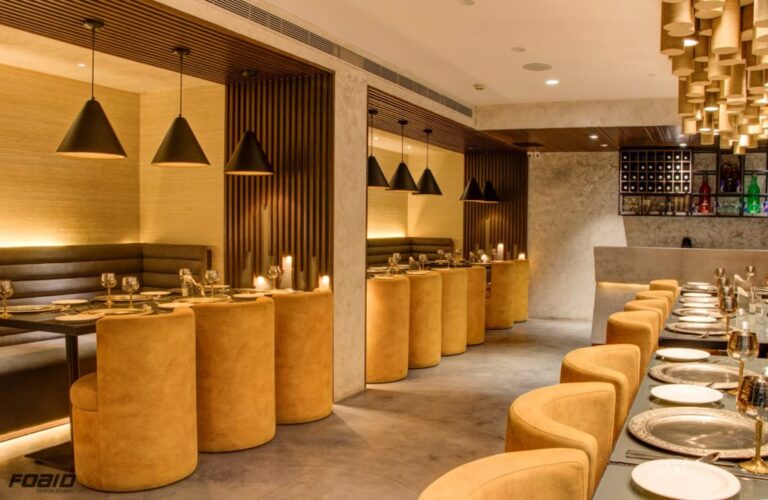

It’s simple yet voguish; the food feels palatable under such warm lighting. Note that fine dining restaurants avoid extra bright lighting fixtures and prefer a lighter hue of yellow or blue lights because they want to create a lighting balance for various customers. This makes it easier for visitors to skim through the menu, the staff to navigate, and the décor lights to resonate with the interiors.
The designers have gone to the extent of the seating arrangement being aligned in proportion with the air conditioners for a quiet dining affair. Above all, the repetition of different shades of brown contrasts sharply with the grey background, and the smooth texture of the surface balance all the visual elements of the restaurant design.
While the wooden theme gives a vintage vibe to the visitors, the drinks bar is visible at the corner while eating, so customers will buy a drink even if they initially did not plan to drink one. Also, the perfect shape of lamps, tables, seating chairs, and the ratio of space between each of them add desirable proximity to the final look.
It’s professional yet cosy, targeting customers who prefer sleek settings and formal dinners.
Talk to our design experts to learn more about different restaurant design concepts.
4. GARDEN RESTAURANT CONCEPT
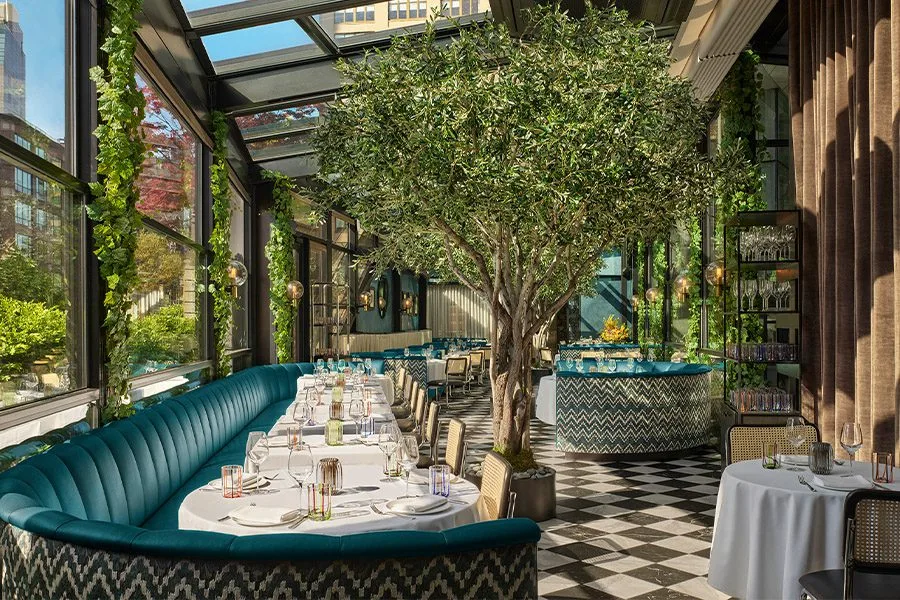

Garden designs have a unique advantage of producing natural scents to enhance customer senses. However, the plant selection is pivotal to the holistic layout of the restaurant.
Furthermore, the seeping of natural sunlight creates an organic effect making you feel cosy and relaxing. Since the greenery purifies the air and looks visually welcoming, visitors are almost guaranteed a soothing atmosphere.
Firstly, the alignment of a combination of herbs and shrubs with a few hanging pots is an effective strategy to project the restaurant theme.
Secondly, the menu should consist of plant-based items alongside other dishes.
Lastly, music that is neither too high nor too low works best in a garden setting. Customers should feel connected to the concept because they flock to green restaurants to enjoy the feel of nature, eat light snacks, and experience the outcome of organic meals – all amid nature-centric surroundings. Hence, every element should depict the organic concept of the restaurant design.
